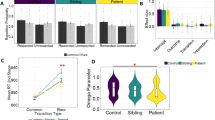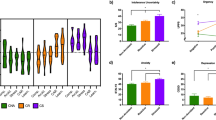Abstract
Preliminary neuroimaging studies suggest that patients with the ‘compulsive hoarding syndrome’ may be a neurobiologically distinct variant of obsessive-compulsive disorder (OCD) but further research is needed. A total of 29 OCD patients (13 with and 16 without prominent hoarding symptoms) and 21 healthy controls of both sexes participated in two functional magnetic resonance imaging experiments consisting of the provocation of hoarding-related and symptom-unrelated (aversive control) anxiety. In response to the hoarding-related (but not symptom-unrelated) anxiety provocation, OCD patients with prominent hoarding symptoms showed greater activation in bilateral anterior ventromedial prefrontal cortex (VMPFC) than patients without hoarding symptoms and healthy controls. In the entire patient group (n=29), provoked anxiety was positively correlated with activation in a frontolimbic network that included the anterior VMPFC, medial temporal structures, thalamus and sensorimotor cortex. Negative correlations were observed in the left dorsal anterior cingulate gyrus, bilateral temporal cortex, bilateral dorsolateral/medial prefrontal regions, basal ganglia and parieto-occipital regions. These results were independent from the effects of age, sex, level of education, state anxiety, depression, comorbidity and use of medication. The findings are consistent with the animal and lesion literature and several landmark clinical features of compulsive hoarding, particularly decision-making difficulties. Whether the results are generalizable to hoarders who do not meet criteria for OCD remains to be investigated.
This is a preview of subscription content, access via your institution
Access options
Subscribe to this journal
Receive 12 print issues and online access
$259.00 per year
only $21.58 per issue
Buy this article
- Purchase on Springer Link
- Instant access to full article PDF
Prices may be subject to local taxes which are calculated during checkout



Similar content being viewed by others
References
Steketee G, Frost R . Compulsive hoarding: current status of the research. Clin Psychol Rev 2003; 23: 905–927.
Mataix-Cols D, Rosario-Campos MC, Leckman JF . A multidimensional model of obsessive-compulsive disorder. Am J Psychiatry 2005; 162: 228–238.
Samuels JF, Bienvenu III OJ, Pinto A, Fyer AJ, McCracken JT, Rauch SL et al. Hoarding in obsessive-compulsive disorder: resulting from the OCD collaborative genetics study. Behav Res Ther 2006; 45: 673–686.
Anderson SW, Bechara A, Damasio H, Tranel D, Damasio AR . Impairment of social and moral behavior related to early damage in the human prefrontal cortex. Nat Neurosci 1999; 2: 1032–1037.
Cohen L, Angladette L, Benoit N, Pierrot-Deseilligny C . A man who borrowed cars. Lancet 1999; 353: 34.
Hahm DS, Kang Y, Cheong SS, Na DL . A compulsive collecting behavior following an A-com aneurysm rupture. Neurology 2001; 56: 398–400.
Ogai M, Iyo M, Mori N, Takei N . A right orbitofrontal region and OCD symptoms: a case report. Acta Psychiatr Scand 2005; 111: 74–77.
Volle E, Beato R, Levy R, Dubois B . Forced collection after orbitofrontal damage. Neurology 2002; 58: 488–490.
Anderson SW, Damasio H, Damasio AR . A neural basis for collecting behaviour in humans. Brain 2005; 128: 201–212.
Blundell JE, Herberg LJ . Effectiveness of lateral hypothalamic stimulation, arousal, and food deprivation in the initiation of food hoarding behavior in naïve rats. Physiol Behav 1977; 18: 237–244.
Kolb B . Studies on the caudate-putamen and dorsomedial thalamic nucleus of the rat: implications for mammalian frontal-lobe functions. Physiol Behav 1977; 18: 237–244.
Stern CE, Passingham RE . The nucleus accumbens in monkeys (Macaca fascicularis): I. The organization of behavior. Behav Brain Res 1994; 61: 9–21.
Mataix-Cols D, Cullen S, Lange K, Zelaya F, Andrew C, Amaro E et al. Neural correlates of anxiety associated with obsessive-compulsive symptom dimensions in normal volunteers. Biol Psychiatry 2003; 53: 482–493.
Saxena S, Brody AL, Maidment KM, Smith EC, Zohrabi N, Katz E et al. Cerebral glucose metabolism in obsessive-compulsive hoarding. Am J Psychiatry 2004; 161: 1038–1048.
Mataix-Cols D, Wooderson S, Lawrence N, Brammer MJ, Speckens A, Phillips ML . Distinct neural correlates of washing, checking and hoarding symptom dimensions in obsessive-compulsive disorder. Arch Gen Psychiatry 2004; 164: 564–576.
Goodman WK, Price LH, Rasmussen SA, Mazure C, Delgado P, Heninger GR et al. The Yale-Brown Obsessive Compulsive Scale (Y-BOCS). Part I: development, use and reliability. Arch Gen Psychiatry 1989; 46: 1006–1011.
Frost RO, Steketee G, Grisham J . Measurement of compulsive hoarding: saving inventory-revised. Behav Res Ther 2004; 42: 31163–31182.
Lawrence NS, Wooderson S, Mataix-Cols D, David R, Speckens A, Phillips ML . Decision making and set shifting impairments are associated with distinct symptom dimensions in obsessive-compulsive disorder. Neuropsychology 2006; 20: 409–419.
Frost RO, Hartl T . A cognitive-behavioral model of compulsive hoarding. Behav Res Ther 1996; 34: 341–350.
Mataix-Cols D, Lawrence NS, Wooderson S, Speckens A, Phillips ML . The Maudsley Obsessive-Compulsive Stimuli Set (MOCSS): validation of a standardized paradigm for symptom-specific provocation in obsessive-compulsive disorder (OCD). Submitted.
First MB, Spitzer RL, Gibbon M, Williams JBW . Structured Clinical Interview for DSM-IV Axis I Disorders—Patient Edition. Biometrics Research Department of the New York State Psychiatric Institute: New York, 1995.
First MB, Gibbon M, Spitzer RL, Williams JBW, Smith Benjamin L . Structured Clinical Interview for DSM-IV Axis II Disorders—Patient Edition. Biometrics Research Department of the New York State Psychiatric Institute: New York, 1995.
Tortella-Feliu M, Fullana MA, Caseras X, Andion O, Torrubia R, Mataix-Cols D . Spanish version of the saving inventory-revised: adaptation, psychometric properties, and relationship to personality variables. Behav Modif 2006; 30: 693–712.
Foa EB, Huppert JD, Leiberg S, Langner R, Kichic R, Hajcak G et al. The obsessive-compulsive inventory: development and validation of a short version. Psychol Assess 2002; 14: 485–496.
Beck AT, Ward CH, Mendelson M, Mock J, Erbaugh J . An inventory for measuring depression. Arch Gen Psychiatry 1961; 4: 561–571.
Spielberger CD . Manual for the State-Trait Anxiety Inventory (STAI). Consulting Psychologists Press: Palo Alto, 1983.
Marks DF . Bibliography of research utilizing the Vividness of Visual Imagery Questionnaire. Percept Mot Skills 1989; 69: 707–718.
Cromer KR, Schmidt NB, Murphy DL . Do traumatic events influence the clinical expression of compulsive hoarding? Behav Res Ther 2007; 45: 2581–2592.
Lang PJ, Bradley MM, Cuthbert BN . International Affective Picture System (IAPS). NIMH Center for Study of Emotion and Attention: New York, 1997.
Ogawa S, Lee TM, Kay AR, Tank DW . Brain magnetic resonance imaging with contrast dependent blood oxygenation. Proc Natl Acad Sci USA 1990; 87: 8868–8872.
Bullmore ET, Brammer M, Rabe-Hesketh S, Curtis V, Morris R, Williams SCR et al. Methods for the diagnosis and treatment of stimulus correlated motion in generic brain activation studies using fMRI. Hum Brain Mapp 1999; 7: 38–48.
Friman O, Borga M, Lundberg P, Knutsson H . Adaptive analysis of fMRI data. Neuroimage 2003; 19: 837–845.
Bullmore ET, Long C, Suckling J, Fadili J, Calvert GA, Zelaya F et al. Coloured noise and computational inference in neurophysiological (fMRI) time series analysis: resampling methods in time and wavelet domains. Hum Brain Mapp 2001; 12: 61–78.
Talairach J, Tournoux P . Co-planar Stereotactic Atlas of the Human Brain. Thieme: Stuttgart, 1988.
Brammer M, Bullmore ET, Simmons A, Williams SCR, Grasby PM, Howard RJ et al. Generic brain activation mapping in functional magnetic resonance imaging: a nonparametric approach. Magn Reson Imaging 1997; 15: 763–770.
Bullmore ET, Suckling J, Overmeyer S, Rabe-Hesketh S, Taylor E, Brammer MJ . Global, voxel and cluster tests, by theory and permutation, for a difference between two groups of structural MR images of the brain. IEEE Trans Med Imaging 1999; 18: 32–42.
Rorden C, Brett M . Stereotaxic display of brain lesions. Behavioural Neurology 2000; 12: 191–200.
Bechara A, Damasio AR . The somatic marker hypothesis: a neural theory of economic decision. Game Econ Behav 2005; 52: 336–372.
Bechara A, Damasio AR, Damasio H, Anderson SW . Insensitivity to future consequences following damage to human prefrontal cortex. Cognition 1994; 50: 7–15.
Bechara A, Tranel D, Damasio H . Characterization of the decision-making deficit of patients with ventro-medial prefrontal cortex lesion. Brain 2000; 123: 2189–2202.
Fukui T, Murai T, Fukuyama H, Hayashi T, Hanakawa T . Functional activity related to risk anticipation during performance of the Iowa Gambling Task. Neuroimage 2005; 24: 253–259.
Northoff G, Grimm S, Boeker H, Schmidt C, Bermpohl F, Heinzel A et al. Affective judgment and beneficial decision making: ventromedial prefrontal activity correlates with performance in the Iowa Gambling Task. Hum Brain Mapp 2006; 27: 572–587.
Clark L, Cools R, Robbins TW . The neuropsychology of ventral prefrontal cortex: decision-making and reversal learning. Brain Cogn 2004; 55: 41–53.
Kringelbach ML, Rolls ET . The functional neuroanatomy of the human orbitofrontal cortex: evidence from neuroimaging and neuropsychology. Prog Neurobiol 2004; 72: 341–372.
Kringelbach ML . The human orbitofrontal cortex: linking reward to hedonic experience. Nat Rev Neurosci 2005; 6: 691–702.
Adolphs R, Damasio H, Tranel D, Cooper G, Damasio AR . A role for somatosensory cortices in the visual recognition of emotion as revealed by three-dimensional lesion mapping. J Neurosci 2000; 20: 2683–2690.
Walton ME, Croxson PL, Behrens TE, Kennerley SW, Rushworth MF . Adaptive decision making and value in the anterior cingulate cortex. Neuroimage 2007; 36 (Suppl 2): T142–T154.
Taylor SF, Liberzon I . Neural correlates of emotion regulation in psychopathology. Trends Cogn Sci 2007; 11: 413–418.
van den Heuvel OA, Veltman DJ, Groenewegen HJ, Cath DC, van Balkom AJLM, van Hartskamp J et al. Frontal-striatal dysfunction during planning in obsessive-compulsive disorder. Arch Gen Psychiatry 2005; 62: 301–310.
Hartl TL, Frost RO, Allen GJ, Deckersbach T, Steketee G, Dufany SR et al. Actual and perceived memory deficits in individuals with compulsive hoarding. Depress Anxiety 2004; 20: 59–69.
Acknowledgements
We thank the MRI team of the Institute of Psychiatry for their help with the design and MRI physics of this project and Dr Odile van den Heuvel for her helpful comments on an earlier draft. This study was funded by project grant no. 064846 from the Wellcome Trust, UK and a pilot grant from the South London and Maudsley NHS Trust.
Author information
Authors and Affiliations
Corresponding author
Rights and permissions
About this article
Cite this article
An, S., Mataix-Cols, D., Lawrence, N. et al. To discard or not to discard: the neural basis of hoarding symptoms in obsessive-compulsive disorder. Mol Psychiatry 14, 318–331 (2009). https://doi.org/10.1038/sj.mp.4002129
Received:
Revised:
Accepted:
Published:
Issue Date:
DOI: https://doi.org/10.1038/sj.mp.4002129
Keywords
This article is cited by
-
The prefrontal cortex and OCD
Neuropsychopharmacology (2022)
-
Increased cerebellar–default-mode network connectivity at rest in obsessive–compulsive disorder
European Archives of Psychiatry and Clinical Neuroscience (2020)
-
Reduced focal fiber collinearity in the cingulum bundle in adults with obsessive-compulsive disorder
Neuropsychopharmacology (2019)
-
Obsessive-compulsive disorder is a heterogeneous disorder: evidence from diffusion tensor imaging and magnetization transfer imaging
BMC Psychiatry (2015)
-
Obsessive–compulsive disorder: an integrative genetic and neurobiological perspective
Nature Reviews Neuroscience (2014)



